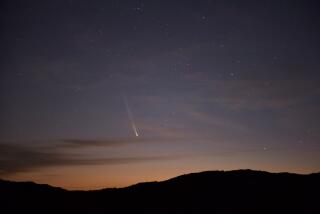Rosetta spacecraft days away from comet rendezvous, a Space Age first
- Share via
The European Space Agency’s Rosetta spacecraft is scheduled to catch up with a comet Wednesday, the end of a harrowing journey 10 years in the making.
It’s an amazing feat of engineering that has never been attempted before. The comet in question is the size of a mountain and hurtling through space at about 34,000 mph on its 6.5-year orbit around the sun.
Rosetta is just 9 feet high and 7 feet wide, but it has the largest solar array ever sent into space, stretching more than 100 feet from tip to tip.
Since its launch in March 2004, the spacecraft has traveled an epic 4 billion miles, picked up three gravity assists from Earth and one from Mars, flown through the asteroid belt twice, and spent two-and-a-half years in hibernation to conserve energy.
Inside its cube-like body it’s carrying another spacecraft, a lander called Philae, that the European Space Agency is planning to send down to the comet in November.
“We can’t bring samples of the comet to the lab, so we’re bringing the lab to the comet,” said Joel Parker, deputy principal investigator for one of Rosetta’s suite of instruments.
Easy to say, not so easy to do.
Rosetta was successfully awakened from its long electrical slumber early this year. In May, the ESA began a series of engine firings to slow the spacecraft down so it could rendezvous with the comet known as Churyumov-Gerasimeko, or “CG” for short.
On Wednesday, the ESA will complete the last of those engine firings. When that happens, Rosetta will be about 62 miles from the comet, a distance it plans to stay while it surveys its icy target, studying CG’s topography and looking for the best place for Philae to land.
But even after Philae is deployed, Rosetta’s work will not be done. While the lander is busy drilling into the comet, Rosetta will continue to chaperone CG as it flies toward the sun, watching and measuring as our star’s radiation reaches the comet’s frozen nucleus, releasing gases that have been in a deep freeze for possibly billions of years.
The mission plan has Rosetta accompanying CG until the end of 2015 at least.
Comets are strange beasts - notoriously unpredictable, and no two seem to be exactly alike. Scientists believe they are made of the frozen detritus of the early solar system, and that they may have delivered water and organic molecules, the very building blocks of life, to our planet.
Does life on Earth owe its origins to a cometary collision? Rosetta may help us find out.
Do you love to learn? Follow me @DeborahNetburn and “like” Los Angeles Times Science & Health on Facebook.







